About
Current smart instrumentation using multi-sensors and/or spectrometers provides a wealth of data that requires sophisticated signal and data processing approaches to extract the hidden information.
Our group develops algorithmic solutions for the automatic processing of Gas Sensor Array, Gas Chromatography – Ion Mobility Spectrometry (IMS), Nuclear Magnetic Resonance, and Mass Spectrometry (GC/LC-MS, MSI) data for metabolomics, food, and environmental samples.
In this context, we are interested in intelligent chemical instruments for the detection of gases, volatile compounds, and smells. These systems can be based on an array of nonspecific chemical sensors with a pattern recognition engine, taking inspiration from the olfactory system. Some spectrometries, e.g. Ion Mobility Spectrometry, are capable of very fast analysis with good detection limits but poor selectivity. These technologies have been proposed for the fast determination of the volatolome (volatile fraction of the metabolome), instead of the reference technique of gas chromatography – mass spectrometry.
During 2023 our research has been focused on:
- Development of computational metabolomics workflows based on advanced statistics and machine learning. We have applied these methods to the discovery of metabolic biomarkers to identify patients at risk after colorectal cancer surgery.
- Computational metabolic biomarker discovery for ventilation therapy needs in COVID patients in intensive care units.
- Optimization of a full workflow for the analysis of Gas Chromatography-Ion Mobility Spectrometry (GC-IMS) data, and its implementation in an open source R-package made available for the community.
- Development of a Forced Oscillation Technique apparatus and controlling software for the measurement of the respiratory impedance. The device is controlled by a mobile app, and it has full IoT capabilites (based on Microsoft Azure) for clinician remote access to measurement data. Hardware and Software are open source.
- Development of drones with machine olfaction capabilities for gas source localization and mapping. Our results have shown that nanodrones with proper signal processing can locate sources in indoor scenarios, particularly for chemical sources located above the drone.
- Development of drones with machine olfaction capabilities for outdoor operation aiming to estimate odour concentration as for EN13725 in flight conditions over wastewater treatment plants.
- Development of methods of urine analysis based on GC-IMS.
- Analysis of urine GC-IMS data to develop predictive models of Colorectal Cancer.
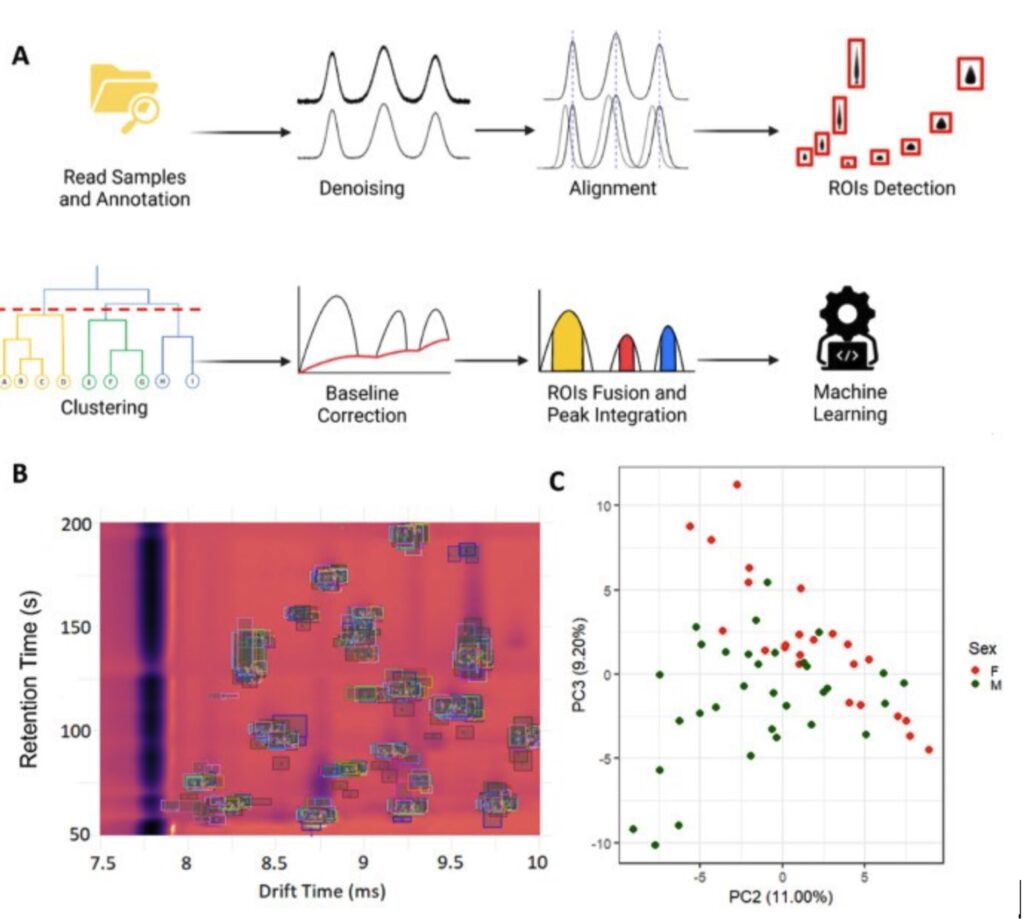
Staff
Projects
| NATIONAL PROJECTS | FINANCER | PI |
|---|---|---|
| TENSOMICS · Development of tensorial signal processing and machine learning tools tailored to the analysis of urine metabolomics (2019-2022) | Ministerio de Ciencia, Innovación y Universidades | Santiago Marco |
| PRIVATELY FUNDED PROJECTS | FINANCER | PI |
|---|---|---|
| Anticipation of respiratory outcomes in ICU COVID-19 patients by metabolic signatures (2021-2023) | Fundació La Marató de TV3 | Santiago Marco |
| FINISHED PROJECTS | FINANCER | PI |
|---|---|---|
| SNIFFDRONE · Drone-based Environmental Odor Monitoring (2019-2020) | EU Commission · Attract Projects | Santiago Marco |
| Analisis de tapones de corcho por espectroscopia de movilidad de iones (2015-2016) | M3C INDUSTRIAL AUTOMATION & VISION, S.L. | Santiago Marco |
| Sensor test for indoor air quality and safety applications (2015-2016) | BSH Electrodomesticos España S.A. | Santiago Marco |
| Preparació i realització d’un curs de processat de senyal per sensors químics de dos dies a BSH Zaragoza (2016-2017) | BSH Electrodomesticos España S.A. | Santiago Marco |
| SMART-IMS Procesado de Señal para Espectroscopia de Movilidad de Iones: Análisis de Fluidos Biomédicos y Detección de Sustancias Tóxicas (2012-2015) | MINECO, I+D-Investigación fundamental no orientada | Santiago Marco |
| Transducción biomimética para olfacción artificial | MINECO, EUROPA EXCELENCIA | Agustín Gutiérrez |
| BIOENCODE Estudio comparativo de la capacidad de codificación de información química de sistemas biológicos y artificiales | MINECO, I+D-Investigación fundamental no orientada | Agustín Gutiérrez |
| SENSIBLE Sensores inteligentes para edificios más seguros (2014-2016) | MINECO, Acciones de Programación Conjunta Internacional | Santiago Marco |
| SAFESENS Sensor Technologies for Enhanced Safety and Security of Buildings and its Occupants (2014-2017) | ENIAC Joint Undertaking | Santiago Marco |
| SIGVOL Mejora de la señal para instrumentación química: aplicaciones en metabolómica de volátiles y en olfacción (2015-2017) | MINECO, Retos investigación: Proyectos I+D | Santiago Marco |
| Computational Metabolomics (2017-2019) | Industrial Project with Nestlé Institute of Health Sciences, Switzerland | Santiago Marco |
| Development of Data Processing Algorithms for Temperature Modulated Sensors | Industrial Project with BSH Electrodomesticos, Spain | Santiago Marco |
Publications
Equipment
- Gas chromatograph/mass spectrometer (Thermoscientific) with robotic head-space sampler
- Gas Chromatograph/ Thermal Conductivity Detector (Thermoscientific) with robotic head-space sampler
- 2 Infusion pumps K-systems
- Gas Chromatography-Ion Mobility Spectrometry FlavourspecTM (Gas Dortmund)
- 6 channel vapor generator plus humidity control (Owlstone, UK)
- Ion Mobility Spectrometer: Gas Detector Array (Airsense Analytics GmbH)
- Computing and General Purpose Electronic Instrumentation
- Field Asymmetric Ion Mobility Spectrometer (Owlstone, UK)
- Corona Discharge Ion Mobility Spectrometer (3QBD, Israel)
- Ultraviolet Ion Mobility Spectrometer (Gas Dortmund, Germany)
- Fast Photo Ionization Detector (Aurora Scientific, Canada)
Collaborations
- Prof. James Covington, Dept. of Electric and Electronic Engineering, University of Warwick, UK
- Dr. Oscar Pozo, Applied Metabolomics, IMIM, Barcelona, ES.
- Dr. Joan R. Masclans, Critical Care Unit, Hospital del Mar, Barcelona, ES.
- Prof. R. Farre, Biofísica Respiratoria i bioenginyeria, IDIBAPS, Barcelona, ES.
- Prof. L. Capelli, Chemical Engineering, Politecnico di Milano, Milano, IT.
- Prof. R. Dellaca, Biomedical Enginering, Politecnico di Milano, Milano, IT.
- Prof. Alessia Amelio, Computer Science & Engineering, Universita degli Studi G. d’Annuncio, Chieti, IT.
- Dr. Radislav Potyrailo, General Electric Research, Schenectady, NY, USA
News
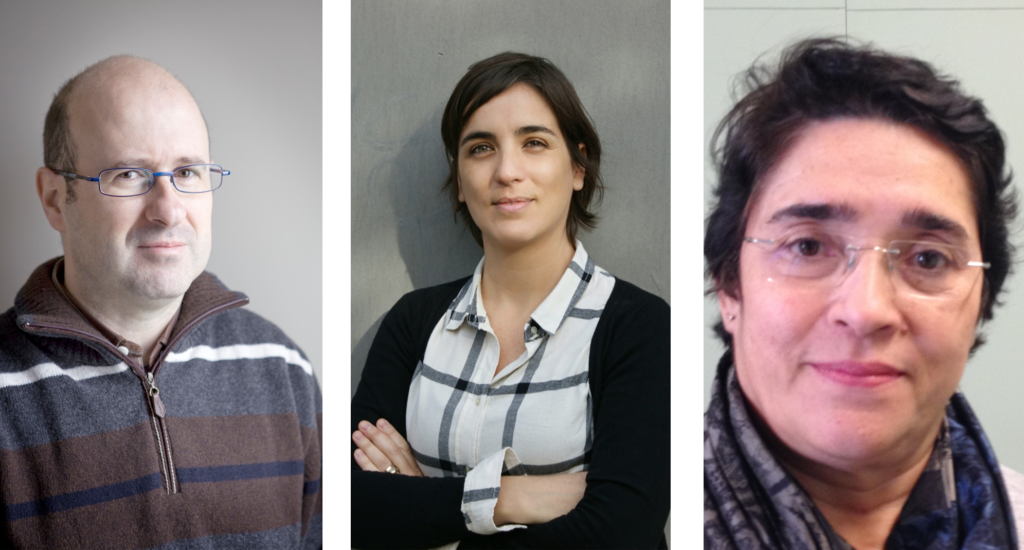
Bioengineering against COVID-19 receives a new boost thanks to “La Marató”
Three projects of the Institute for Bioengineering of Catalonia (IBEC) will receive funding from “La Marató de TV3” to investigate different aspects of COVID-19. Thanks to the contributions received, the experts will deepen their understanding of the disease and its possible therapeutic solutions, study improvements in patient care processes, develop a system to predict the evolution of the respiratory system, and advance in the treatment of patients with pneumonia derived from COVID19.
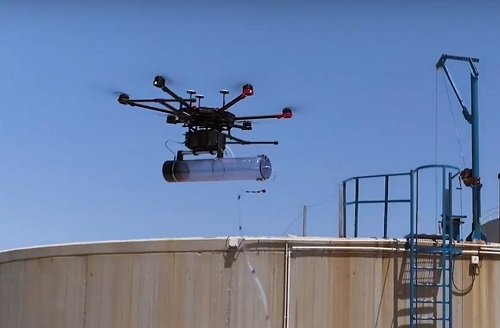
DAM and IBEC develop a drone that improves odor management in water treatment plants
The company Depuración de Aguas del Mediterráneo (DAM) and the Institute for Bioengineering of Catalonia (IBEC) develop a system equipped with chemical sensors that provides information, in real time, on the intensity and location of odor sources in the Waste Water Treatment Plants (WWTP). The system has been calibrated and validated under real operating conditions through several measurement campaigns at the Molina de Segura WWTP (Murcia).

IBEC developes a software for biomarker discovering
International researchers led by Santi Marco at IBEC develop a software for biomarker discovery in samples such as urine, blood or cell extracts. AlpsNMR: An R tool for Automated spectraL Processing System for untargeted NMR-based metabolomics has been made public in the main repository for bioinformatics open software: Bioconductor

A nanodrone able to detect toxic gases in emergencies
Researchers of the Signal and information processing for sensing systems research group at IBEC, led by Santiago Marco, have designed a nanodrone that could identify toxic gases in buildings that collapsed due the effects of earthquakes or explosions. The new gadget, which weights thirty-five grams, could be useful to detect the presence of victims in closed spaces which are hard to enter. Detecting dangerous gases in collapsed buildings due earthquakes or explosions and identifying the presence of victims in places which are hard to access are some action scenarios of SNAV (Smelling Nano Aerial Vehicle), a nanodrone designed and created by the researchers Santiago Marco and Javier Burgués, from the Faculty of Physics of the University of Barcelona and the Institute for Bioengineering of Catalonia (IBEC).

Santiago Marco is the new vice-president of the International Society for Olfaction and Chemical Sensing
Santiago Marco, group leader of the Signal and information processing for sensing systems research group at IBEC has recently been appointed vice-president for the next two years of the International Society for Olfaction and Chemical Sensing (ISOCS) during the general assembly held at the International Symposium on Olfaction and Electronic Nose Conference (ISOEN) in ACROS, Fukuoka, Japan. The ISOCS was launched in May 2008 by the Network of Excellence General Olfaction and Sensing Projects on a European Level (GOSPEL), the EU Network of Excellence in artificial olfaction, and Santiago Marco is one of its founding partners.
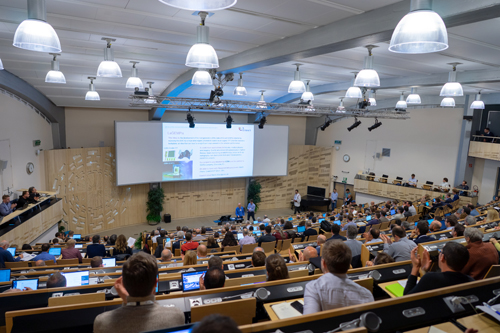
Two projects of the ATTRACT program for IBEC researchers
Santiago Marco, group leader of the Signal and Information Processing for Sensing Systems and Samuel Ojosnegros, Head of Bioengineering in Reproductive Health and have been selected for their research projects in the ATTRACT programme. The call received more than 1200 projects and only 170 proposals were selected. The ATTRACT programme is a pioneering Horizon 2020 research and innovation project funded by the European Union and backed by a consortium of 9 partners. The main objective of this programme is to create a co-innovation ecosystem between fundamental research and industrial communities to develop breakthrough detection and imaging technologies for scientific and commercial uses.
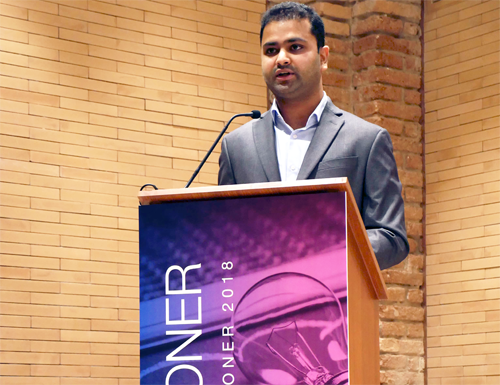
Third IBEC student wins PIONER prize for thesis
Jemish Parmar from IBEC’s Smart Nano-Bio-Devices group has been awarded a Premi Pioner from CERCA for his Doctoral Thesis “Micromotors for Environmental Applications”. Since their launch in 2014, the prizes recognize researchers who present a doctoral thesis with results that are clearly aimed at commercial exploitation. The third IBEC winner of one of these prestigious awards, Jemish was honoured alongside the three other winners – from ICFO, CTFC and IGTP – at a ceremony yesterday. The jury in this fifth edition of the Premis Pioner was made up of Eduard Balbuena (Enterprise Department at UAB), Josep Maria Pujals (IP lawyer at Oficina Ponti), Melba Navarro (Knowledge Transfer Technology Manager at CIMNE Tecnologia), Anna López Lozano (IP expert),


 ibecbarcelona.eu
ibecbarcelona.eu